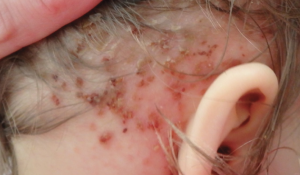Chapter 15: Other Dermatologic Conditions
Langerhans Cell Histiocytosis
What is it?
Langerhans cell histiocytosis (LCH) is an inflammatory neoplasm of dendritic cells primarily in the skin and bone. LCH is most common in children, especially those younger than 3 years old. It has a higher incidence in Caucasian patients than in those of Asian or African descent. LCH most commonly involves the skin and bone, but it may also affect other internal organs, including the liver, spleen, bone marrow, pituitary gland and lungs. There can be a single organ system involved, or multiple. If there is skin involvement usually there is at least one other organ system involved.

What does it look like?
It presents most commonly with erythematous papules, petechiae, and plaques on the trunk, scalp, axilla and groin. These lesions are often crusted and may be itchy.
Consider a diagnosis of LCH if a child has a persistent eruption on the scalp or groin that is not responding to standard treatment, and especially if the child has any systemic symptoms. Rapid referral to dermatology and general pediatrics for biopsy and further assessment is recommended.
How is it treated?
If a diagnosis of LCH is made with systemic involvement these patients are usually primarily managed by the pediatric hemato-oncology team.
The prognosis of LCH depends on several factors, including whether there is single or multi-system disease, and if there is involvement of high-risk organs (liver, spleen, or bone marrow). Single system disease, and multi-system disease without risk organ involvement have a favourable prognosis with a greater than 98% five-year survival.

